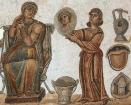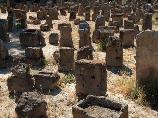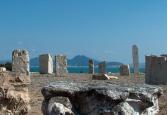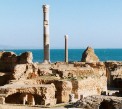Explore tunisia...
Where do you want to go ?
Airports
- Tunis Carthage Airport (TUN)
- Enfidha Airport (NBE)
- Monastir Airport (MIR)
- Djerba-Zarzis Airport (DJE)
- Tozeur-Nefta Airport (TOE)
World Heritage Sites
- Carthage (Kart-Hadasht)
- Dougga (Thugga)
- El Jem (Thysdrus)
- Ichkeul National Park
- Kerkouane
- Kairouan
- Sousse
- Tunis
Beach Resorts
Archaeological Sites
- Bulla Regia (Royal Bulla)
- Chemtou (Simitthus)
- Elles (Megalithic Tombs)
- Haidra (Ammaedara)
- Le Kef (Sicca Veneria)
- Makthar (Mactaris)
- Neapolis
- Oudhna (Uthina)
- Pupput
- Sbeitla (Sufetula)
- Thuburbo Majus
Nature and Traditions
War Graves & Battlefields

Carthage (Kart-Hadasht)
.jpg)
The Phoenician city of Carthage was founded, according to legend, in 814 B.C. Built around Byrsa Hill, it gradually became the most important of the Phoenician settlements along the North African coast. It was reduced to ruins by the conquering Romans in 146 BC. A hundred years later Julius Caesar had the city rebuilt and it went on to become second only to Rome in importance.
Worth visiting:

- The Cathedral: built on Byrsa Hill in the 1980's and today it is used only for cultural purposes. The museum houses items from the Roman era and mosaics.

- The Tophet, or sanctuary of the Carthaginian gods Baal and Tanit, but from this little remains.

- The Punic Ports: once the foundation of Carthaginian prosperity. Carthage was a stronger sea power than Rome for centuries.

- The Antonine Baths: these were once the largest in the Roman empire. They are the best illustration as to how wealthy Carthage was during the Roman era.
Where to stay
- Dar El Medina
- El Mouradi Africa 5*
- Tunisia Palace 4*
- Sheraton Tunis 5*
- El Mechtel 4*
- Yadis Ibn Khaldoun 3*



